-
 Bitcoin
Bitcoin $106,754.6083
1.33% -
 Ethereum
Ethereum $2,625.8249
3.80% -
 Tether USDt
Tether USDt $1.0001
-0.03% -
 XRP
XRP $2.1891
1.67% -
 BNB
BNB $654.5220
0.66% -
 Solana
Solana $156.9428
7.28% -
 USDC
USDC $0.9998
0.00% -
 Dogecoin
Dogecoin $0.1780
1.14% -
 TRON
TRON $0.2706
-0.16% -
 Cardano
Cardano $0.6470
2.77% -
 Hyperliquid
Hyperliquid $44.6467
10.24% -
 Sui
Sui $3.1128
3.86% -
 Bitcoin Cash
Bitcoin Cash $455.7646
3.00% -
 Chainlink
Chainlink $13.6858
4.08% -
 UNUS SED LEO
UNUS SED LEO $9.2682
0.21% -
 Avalanche
Avalanche $19.7433
3.79% -
 Stellar
Stellar $0.2616
1.64% -
 Toncoin
Toncoin $3.0222
2.19% -
 Shiba Inu
Shiba Inu $0.0...01220
1.49% -
 Hedera
Hedera $0.1580
2.75% -
 Litecoin
Litecoin $87.4964
2.29% -
 Polkadot
Polkadot $3.8958
3.05% -
 Ethena USDe
Ethena USDe $1.0000
-0.04% -
 Monero
Monero $317.2263
0.26% -
 Bitget Token
Bitget Token $4.5985
1.68% -
 Dai
Dai $0.9999
0.00% -
 Pepe
Pepe $0.0...01140
2.44% -
 Uniswap
Uniswap $7.6065
5.29% -
 Pi
Pi $0.6042
-2.00% -
 Aave
Aave $289.6343
6.02%
When is the volume-price divergence dangerous? These two forms are the easiest to trap people
Volume-price divergence in crypto signals weakening momentum, like when Bitcoin's price rises but trading volume drops, hinting at a possible bearish reversal.
Jun 16, 2025 at 03:21 am
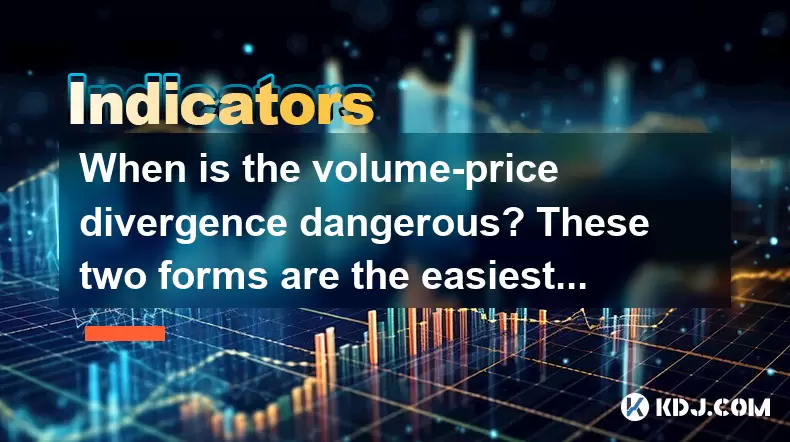
What is Volume-Price Divergence in Cryptocurrency Trading?
In the world of cryptocurrency trading, volume-price divergence refers to a situation where the price of an asset moves in one direction while the trading volume moves in the opposite direction. This divergence can signal weakening momentum and potential reversals. For example, if the price of Bitcoin rises but its trading volume declines, this may indicate that fewer traders are participating in the rally, suggesting a possible bearish reversal.
Understanding this phenomenon is crucial for traders because it often precedes significant market shifts. In crypto markets, which are known for high volatility and speculative behavior, recognizing volume divergence early can help avoid losses or capture profit-taking opportunities.
Why Is Volume-Price Divergence Considered a Warning Signal?
Volume is often seen as the "fuel" behind price movements. When volume doesn't confirm a price move, it suggests that the move lacks conviction. In traditional markets, this is a well-documented pattern, and in cryptocurrency, it's no different — although it can be more exaggerated due to thinner liquidity and higher emotional participation.
A key point here is that volume divergence can act as a trap, especially when inexperienced traders interpret rising prices as strength without checking underlying volume data. This misinterpretation leads many into buying at peaks just before a sharp correction.
Which Two Forms of Volume-Price Divergence Are Most Deceptive?
There are two primary types of volume-price divergence that frequently mislead traders:
- Bullish divergence with declining volume: When the price makes a new high but volume continues to drop, it signals that fewer people are buying into the rally.
- Bearish divergence with rising volume: When the price drops sharply but volume surges, it may look like panic selling, but could also be a short-term washout rather than a sustained downtrend.
These patterns are dangerous because they mimic healthy market behavior. A rising price usually encourages buying, but if volume isn’t backing it up, the rally is likely artificial or driven by whales manipulating the market. Similarly, heavy volume during a sell-off can scare retail traders into exiting positions prematurely.
How Can Traders Spot These Divergences on Charts?
Identifying volume-price divergence requires analyzing both price action and volume bars simultaneously. Here’s how you can do it step-by-step:
- Use a candlestick chart alongside a volume histogram.
- Mark recent swing highs and lows on the price chart.
- Compare each swing with corresponding volume levels.
- Look for discrepancies: for example, a higher high in price with a lower high in volume.
- Overlay indicators like On-Balance Volume (OBV) or Volume Weighted Moving Average (VWMA) to confirm trends.
It’s essential to cross-reference these observations with other technical tools such as RSI or MACD to filter out false signals. In crypto, where pumps and dumps are common, relying solely on price can be misleading — volume acts as a truth filter.
Where Do Novice Traders Usually Fall Into These Traps?
Many novice traders fall into the trap of chasing momentum without verifying whether the movement is supported by real demand. They see a coin rising rapidly and assume it will keep going up, especially if social media or influencers are hyping it. However, if the volume isn’t increasing along with the price, it’s often a sign that the rally is not sustainable.
Another common mistake is panic selling when there's a sudden drop in price accompanied by high volume. While high volume during a downturn might suggest capitulation, it can also be part of a controlled retraction designed to shake weak hands before resuming the trend.
When Should You Treat Volume-Price Divergence as a Red Flag?
You should treat volume divergence as a red flag under the following conditions:
- When price reaches a key resistance level but volume is shrinking — this indicates lack of buyer interest.
- After prolonged uptrends where volume steadily decreases over several candles — a sign of fading momentum.
- During apparent breakout attempts that fail to sustain despite increased hype — often a fakeout orchestrated by large players.
Traders should pay particular attention to divergences that occur after extended moves. These are the moments when the market is most vulnerable to reversals, especially in cryptocurrencies where sentiment can shift overnight.
Frequently Asked Questions
Q: Can volume divergence occur in sideways markets?
Yes, volume divergence can still appear even when the price is range-bound. If volume consistently declines during price bounces within a consolidation zone, it suggests weakening interest and potential breakdowns.
Q: Does volume divergence always lead to a reversal?
No, volume divergence does not guarantee a reversal. It only signals a mismatch between price and volume. Sometimes the price continues despite weak volume, especially during news-driven events or whale manipulation.
Q: How reliable is volume divergence in low-cap cryptocurrencies?
In low-cap coins, volume divergence can be less reliable due to thin order books and the potential for spoofing or wash trading. Always verify divergence using multiple timeframes and external volume sources.
Q: What tools help visualize volume divergence better?
Tools like OBV (On-Balance Volume), VWAP (Volume Weighted Average Price), and volume profile charts can enhance your ability to detect and analyze volume divergence effectively.
Disclaimer:info@kdj.com
The information provided is not trading advice. kdj.com does not assume any responsibility for any investments made based on the information provided in this article. Cryptocurrencies are highly volatile and it is highly recommended that you invest with caution after thorough research!
If you believe that the content used on this website infringes your copyright, please contact us immediately (info@kdj.com) and we will delete it promptly.
- 2025-W Uncirculated American Gold Eagle and Dr. Vera Rubin Quarter Mark New Products
- 2025-06-13 06:25:13
- Ruvi AI (RVU) Leverages Blockchain and Artificial Intelligence to Disrupt Marketing, Entertainment, and Finance
- 2025-06-13 07:05:12
- H100 Group AB Raises 101 Million SEK (Approximately $10.6 Million) to Bolster Bitcoin Reserves
- 2025-06-13 06:25:13
- Galaxy Digital CEO Mike Novogratz Says Bitcoin Will Replace Gold and Go to $1,000,000
- 2025-06-13 06:45:13
- Trust Wallet Token (TWT) Price Drops 5.7% as RWA Integration Plans Ignite Excitement
- 2025-06-13 06:45:13
- Ethereum (ETH) Is in the Second Phase of a Three-Stage Market Cycle
- 2025-06-13 07:25:13
Related knowledge
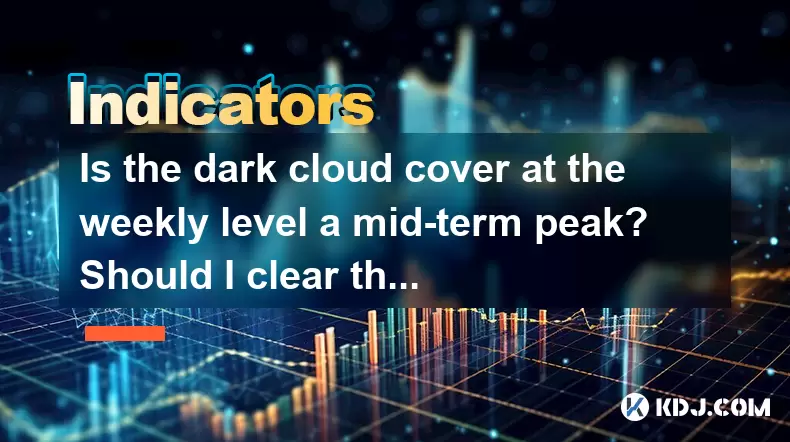
Is the dark cloud cover at the weekly level a mid-term peak? Should I clear the position?
Jun 17,2025 at 02:21pm
Understanding the Dark Cloud Cover PatternThe Dark Cloud Cover is a well-known candlestick pattern used by technical analysts to identify potential trend reversals from bullish to bearish. It typically forms at the end of an uptrend and consists of two candles: the first is a strong bullish (green) candle, followed by a bearish (red) candle that opens h...
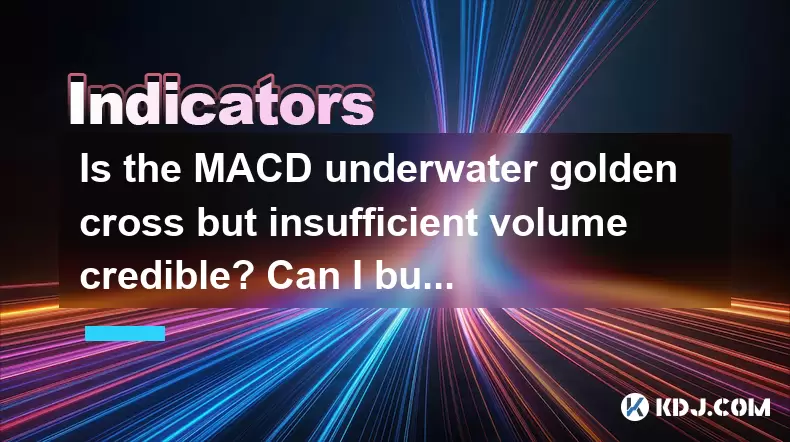
Is the MACD underwater golden cross but insufficient volume credible? Can I buy at the bottom?
Jun 17,2025 at 03:08pm
Understanding the MACD Underwater Golden CrossThe MACD underwater golden cross occurs when the MACD line crosses above the signal line below the zero line, signaling a potential reversal from a downtrend to an uptrend. This phenomenon is often interpreted by traders as a bullish signal, especially in cryptocurrency markets where momentum plays a signifi...
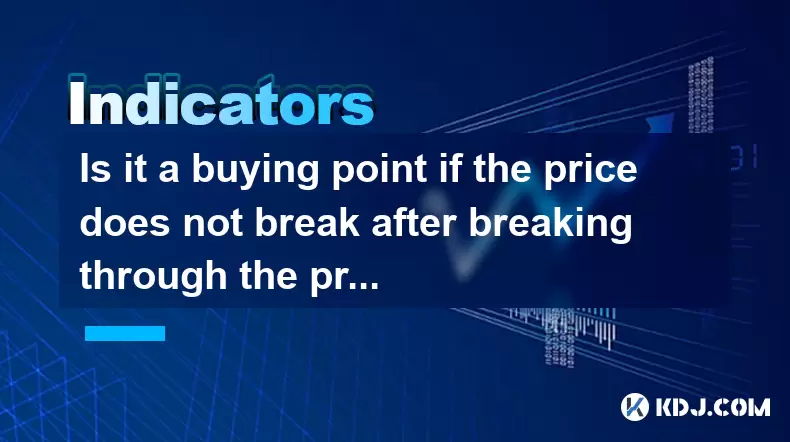
Is it a buying point if the price does not break after breaking through the previous high? How to confirm?
Jun 17,2025 at 01:22pm
Understanding Price Behavior After Breaking Previous HighsWhen analyzing cryptocurrency price charts, traders often look for breakouts as potential signals for new trends. A common question among traders is whether a non-breakdown after breaking through a previous high indicates a buying opportunity. To answer this, it's essential to understand the psyc...
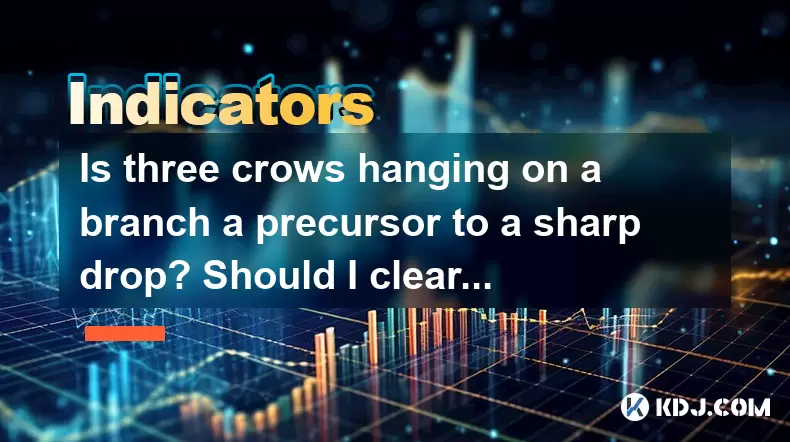
Is three crows hanging on a branch a precursor to a sharp drop? Should I clear my position?
Jun 17,2025 at 12:50pm
What Does 'Three Crows Hanging on a Branch' Mean in Crypto Trading?In technical analysis, the 'three crows hanging on a branch' is a candlestick pattern that often signals a potential reversal from an uptrend to a downtrend. This pattern typically appears after a period of rising prices and consists of three consecutive bearish (red) candles with progre...
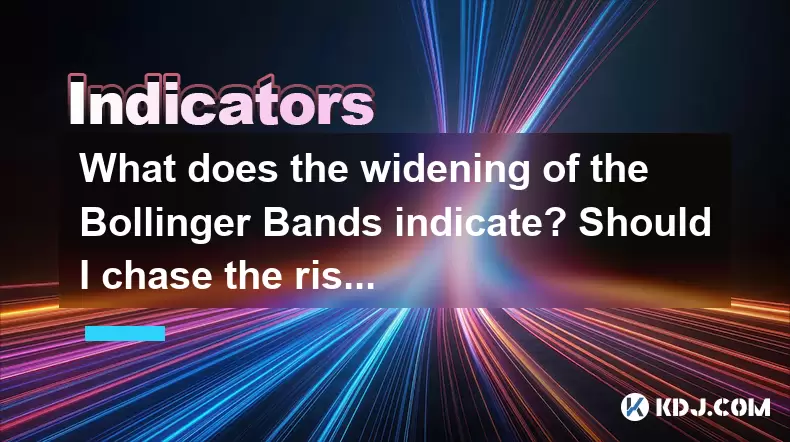
What does the widening of the Bollinger Bands indicate? Should I chase the rise or leave the market?
Jun 17,2025 at 02:28pm
Understanding Bollinger Bands and Their SignificanceBollinger Bands are a widely used technical analysis tool in cryptocurrency trading. They consist of a moving average (typically a 20-day simple moving average) with two standard deviation lines plotted above and below it. These bands dynamically adjust to price volatility, expanding when volatility in...
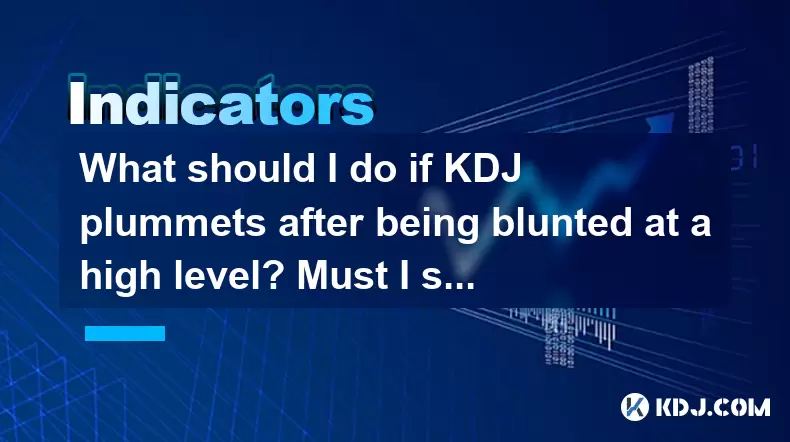
What should I do if KDJ plummets after being blunted at a high level? Must I stop loss?
Jun 17,2025 at 12:01pm
Understanding KDJ Indicator Dynamics in Cryptocurrency TradingThe KDJ indicator, also known as the stochastic oscillator, is a momentum-based tool used to identify overbought and oversold conditions in financial markets, including cryptocurrency. It consists of three lines: the %K line (fast stochastic), the %D line (slow stochastic), and the %J line (d...

Is the dark cloud cover at the weekly level a mid-term peak? Should I clear the position?
Jun 17,2025 at 02:21pm
Understanding the Dark Cloud Cover PatternThe Dark Cloud Cover is a well-known candlestick pattern used by technical analysts to identify potential trend reversals from bullish to bearish. It typically forms at the end of an uptrend and consists of two candles: the first is a strong bullish (green) candle, followed by a bearish (red) candle that opens h...

Is the MACD underwater golden cross but insufficient volume credible? Can I buy at the bottom?
Jun 17,2025 at 03:08pm
Understanding the MACD Underwater Golden CrossThe MACD underwater golden cross occurs when the MACD line crosses above the signal line below the zero line, signaling a potential reversal from a downtrend to an uptrend. This phenomenon is often interpreted by traders as a bullish signal, especially in cryptocurrency markets where momentum plays a signifi...

Is it a buying point if the price does not break after breaking through the previous high? How to confirm?
Jun 17,2025 at 01:22pm
Understanding Price Behavior After Breaking Previous HighsWhen analyzing cryptocurrency price charts, traders often look for breakouts as potential signals for new trends. A common question among traders is whether a non-breakdown after breaking through a previous high indicates a buying opportunity. To answer this, it's essential to understand the psyc...

Is three crows hanging on a branch a precursor to a sharp drop? Should I clear my position?
Jun 17,2025 at 12:50pm
What Does 'Three Crows Hanging on a Branch' Mean in Crypto Trading?In technical analysis, the 'three crows hanging on a branch' is a candlestick pattern that often signals a potential reversal from an uptrend to a downtrend. This pattern typically appears after a period of rising prices and consists of three consecutive bearish (red) candles with progre...

What does the widening of the Bollinger Bands indicate? Should I chase the rise or leave the market?
Jun 17,2025 at 02:28pm
Understanding Bollinger Bands and Their SignificanceBollinger Bands are a widely used technical analysis tool in cryptocurrency trading. They consist of a moving average (typically a 20-day simple moving average) with two standard deviation lines plotted above and below it. These bands dynamically adjust to price volatility, expanding when volatility in...

What should I do if KDJ plummets after being blunted at a high level? Must I stop loss?
Jun 17,2025 at 12:01pm
Understanding KDJ Indicator Dynamics in Cryptocurrency TradingThe KDJ indicator, also known as the stochastic oscillator, is a momentum-based tool used to identify overbought and oversold conditions in financial markets, including cryptocurrency. It consists of three lines: the %K line (fast stochastic), the %D line (slow stochastic), and the %J line (d...
See all articles

























































































